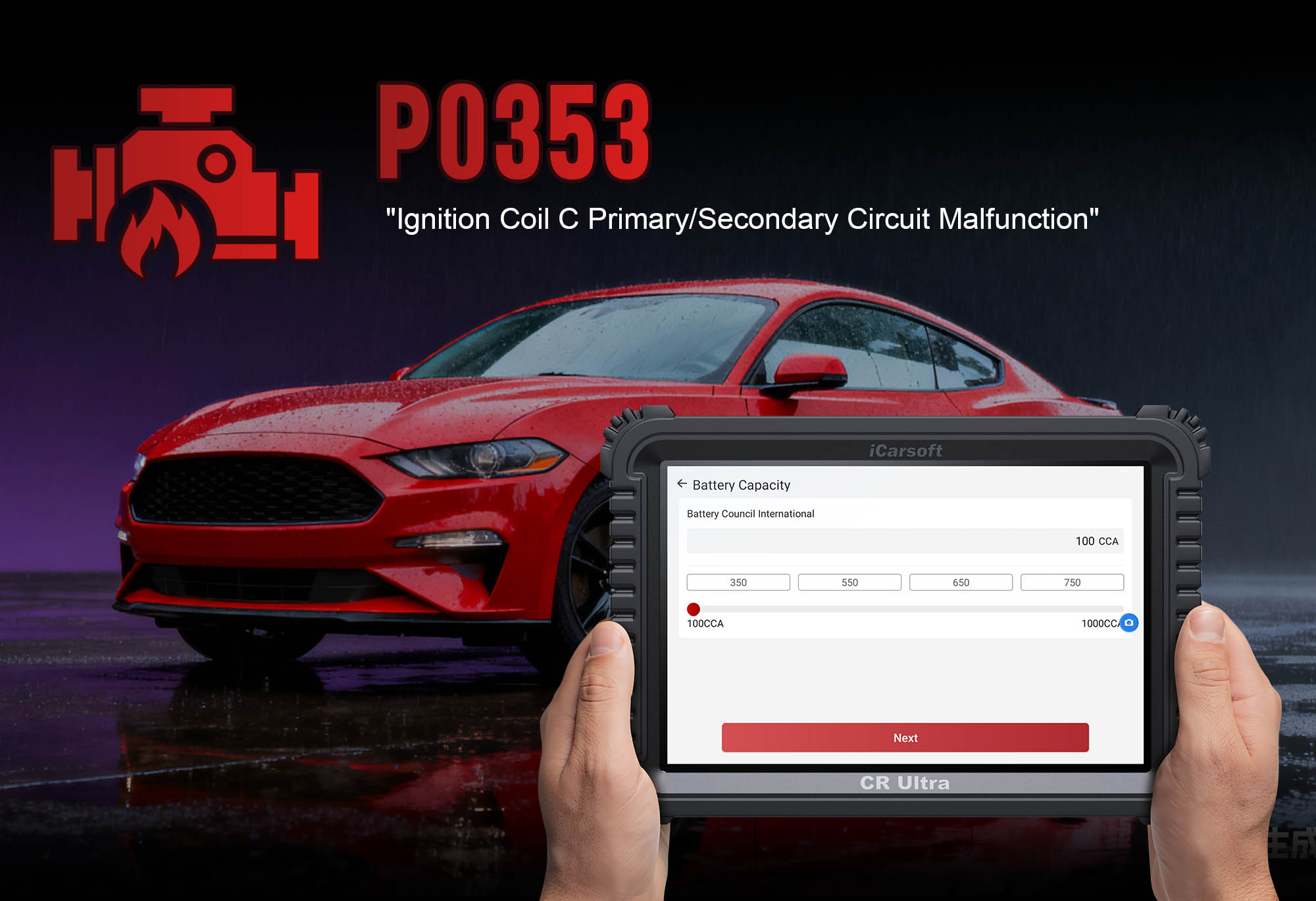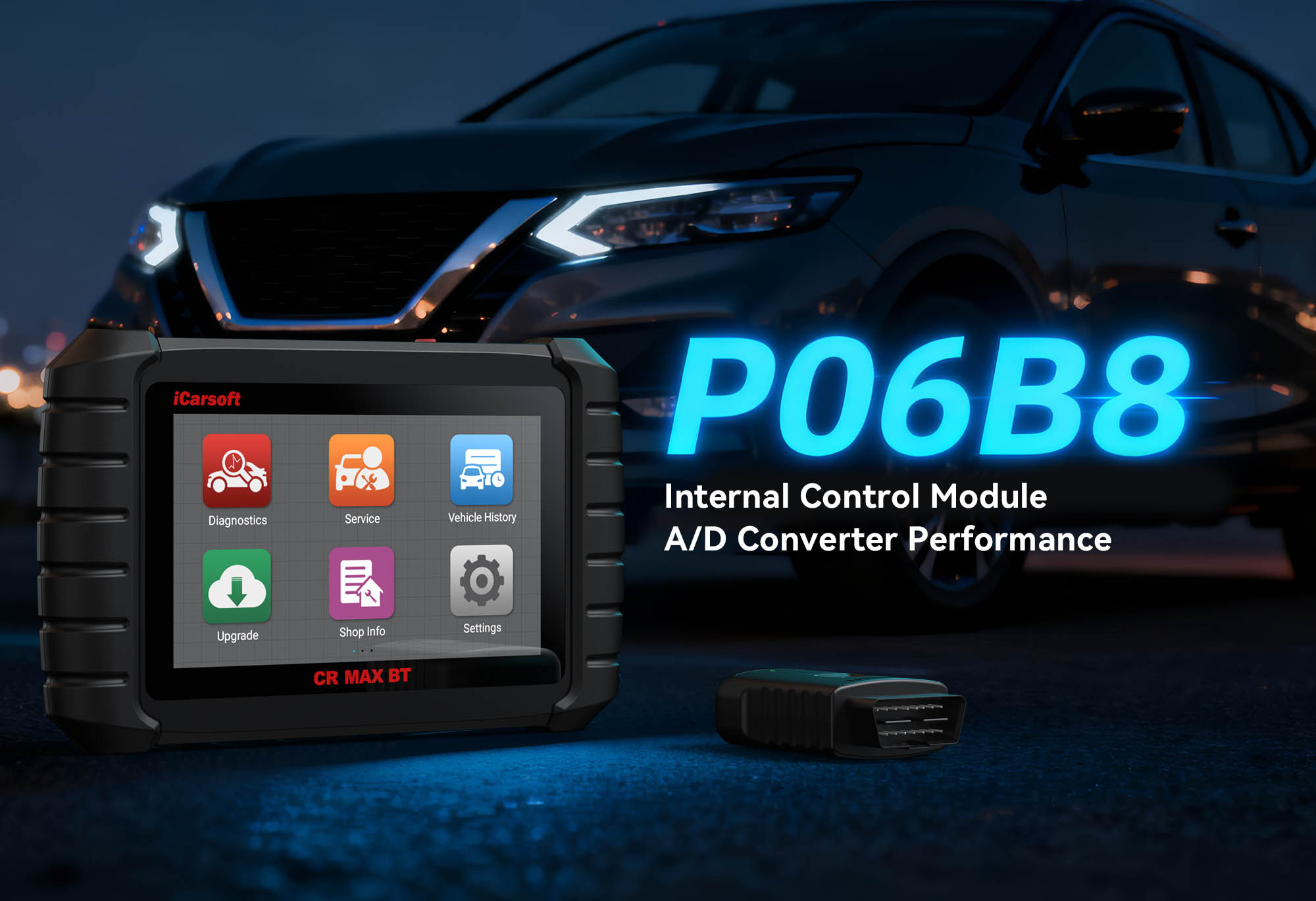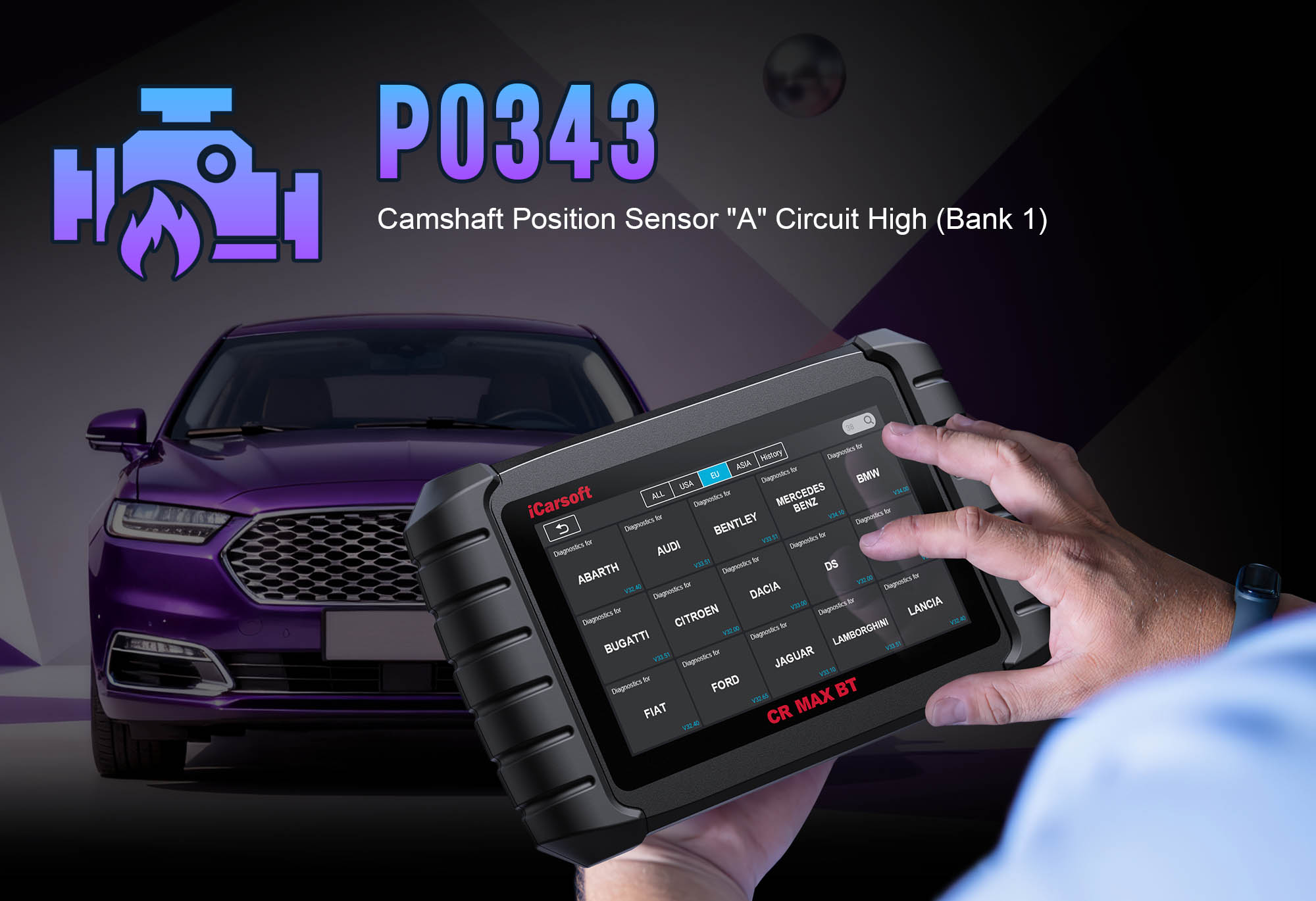P0353 Code: How to Diagnose & Fix Ignition Coil C Malfunction with iCarsoft CR Ultra
If your check engine light illuminates and you notice rough idling, hesitation during acceleration, or even a misfire in one cylinder, a diagnostic scan will likely return P0353. This generic OBD-II code specifically indicates “Ignition Coil C Primary/Secondary Circuit Malfunction,” pointing to a problem with the ignition coil responsible for powering one of your engine’s cylinders (Cylinder 3 in most configurations).
Ignition coils are critical for converting the battery’s low voltage into the high voltage needed to spark the spark plugs, igniting the air-fuel mixture in the cylinders. When Coil C fails—whether due to internal damage, wiring issues, or a faulty connection—the affected cylinder can’t fire properly, leading to performance drops and potential engine damage. Unlike general misfire codes, P0353 directly identifies the problematic coil, but pinpointing the exact cause (coil failure vs. wiring fault) requires precision tools.
Basic scanners may only confirm “Ignition Coil C fault” but can’t test coil functionality or isolate wiring issues. The iCarsoft CR Ultra, with its specialized ignition coil tests, real-time circuit monitoring, and component mapping, solves this. Let’s explore how to diagnose and resolve P0353 using this professional-grade tool.
Understanding P0353: Causes & Key Symptoms
A malfunction in Ignition Coil C disrupts combustion in its paired cylinder, creating distinct performance issues that help identify the fault early.
Key Symptoms of P0353
-
Check Engine Light: Illuminates when the ECM detects irregular voltage or no signal from Ignition Coil C for 2+ drive cycles.
-
Cylinder 3 Misfire: The engine shakes or vibrates, especially at idle, as the unpowered cylinder fails to contribute to combustion.
-
Hesitation or Power Loss: Acceleration feels sluggish, and the engine struggles under load (e.g., climbing hills), as one cylinder isn’t firing.
-
Increased Fuel Consumption: The ECM compensates for the misfire by enriching the fuel mixture, reducing MPG by 10–15%.
-
Rough Idle: RPM fluctuates noticeably at idle, with the engine sometimes stalling if the coil fails completely.
-
Strong Fuel Odor: Unburned fuel from the misfiring cylinder exits the exhaust, creating a noticeable gasoline smell.
Common Causes of P0353
|
Cause
|
Description
|
|
Faulty Ignition Coil C
|
Internal damage (e.g., broken windings, short circuits) prevents the coil from generating the required high voltage (20,000–40,000V).
|
|
Wiring or Connector Issues
|
Corroded terminals, frayed wires, or loose plugs in the coil’s circuit disrupt power flow to Coil C, causing signal drops.
|
|
Failed Spark Plug/Wire
|
A worn spark plug or damaged wire (in coil-on-plug systems) creates excessive resistance, overloading the coil and leading to failure.
|
|
ECM Malfunction
|
A faulty module sends incorrect voltage to Ignition Coil C, causing underperformance—rare but possible in older vehicles.
|
|
Overheating
|
Coils near hot components (e.g., exhaust manifolds) fail prematurely due to heat damage, breaking internal windings.
|
Why iCarsoft CR Ultra Excels at Diagnosing P0353
The CR Ultra outperforms basic scanners with features tailored to ignition coil diagnostics—critical for distinguishing between coil failure, wiring faults, and ECM issues:
Coil-by-Coil Voltage Testing
Sends precise voltage to Ignition Coil C and measures output, verifying if it generates the required high voltage (20,000–40,000V) for spark plugs.
Primary/Secondary Circuit Analysis
Distinguishes faults in the low-voltage primary circuit (battery power) vs. high-voltage secondary circuit (spark plug connection) to avoid misrepairs.
Bi-Directional Control
Manually activates Ignition Coil C to test for spark—eliminates guesswork by letting you visually confirm coil functionality.
3D Component Mapping
Displays high-res diagrams of Coil C’s location, wiring path, and spark plug for 200+ brands (e.g., “Honda Accord: Coil C = Cylinder 3, Passenger Side”).
Resistance Testing
Measures primary (0.5–2 ohms) and secondary (8,000–15,000 ohms) winding resistance to identify internal shorts or opens in the coil.
Live Data Correlation
Cross-references Coil C performance with Cylinder 3’s misfire count and fuel trim to confirm the coil is the root cause (not a secondary issue).
Step-by-Step: Diagnose P0353 with iCarsoft CR Ultra
-
Connect & Confirm the P0353 Code
1. Plug the CR Ultra into your vehicle’s OBD-II port (use included adaptors for older models) and power on the tool.
2. Select your vehicle via Auto VIN Scan (instantly identifies make/model/engine) or manual entry.
3. Navigate to Engine > Fault Codes > Read Codes to confirm P0353. Tap Code Details for vehicle-specific insights (e.g., “Toyota Camry: Coil C = Cylinder 3; Check Connector First”).
-
Locate Ignition Coil C with 3D Mapping
1. Go to Component Location > Engine > Ignition System > Coil Packs > Coil C.
2. Use the 3D diagram to identify:
- Exact position of Coil C (varies by engine: inline-4s = Cylinder 3; V6s = passenger/driver side).
- Wiring harness path (note areas near hot components like exhaust manifolds).
- Spark plug connection (coil-on-plug or wire-fed).
3. Mark the coil’s location to avoid misidentifying other coils during inspection.
-
Analyze Live Ignition Coil Data
1. Start the engine and let it reach operating temperature (5–10 minutes).
2. Navigate to Engine > Live Data > Ignition System > Coil C and monitor:
- Primary Voltage: Should stay 12–14V (matches battery voltage); drops = wiring issue.
- Secondary Output: Must register 20,000–40,000V; no reading = faulty coil.
- Misfire Count (Cylinder 3): Counts >0 confirm the coil isn’t firing properly.
- Current Draw: Normal = 5–8A; spikes >10A = shorted primary windings.
-
Test Coil C Functionality (Bi-Directional)
1. Turn off the engine and remove Cylinder 3’s spark plug; connect it to Coil C and ground the plug to the engine.
2. Go to Special Functions > Engine > Ignition Tests > Coil C Activation.
3. Activate the coil via the tool:
- Good Coil: Visible blue spark from the plug.
- Faulty Coil: No spark or weak orange spark = replace the coil.
-
Inspect Wiring, Connector & Spark Plug
1. Wiring Check: Follow the CR Ultra’s 3D map to look for frayed/burned wires (near exhaust) or loose connections.
2. Connector Test: Clean corroded terminals (white/green deposits) and wiggle the plug while monitoring live data—signal drops confirm loose pins.
3. Spark Plug Inspection: Use the tool’s Torque Guide to remove the plug; check for fouling (oil/carbon) or cracked electrodes—replace if damaged.
-
Rule Out ECM/Power Supply Issues
1. Power Supply Test: Measure voltage at Coil C’s connector (engine running) via the CR Ultra’s multimeter—steady 12V = good; fluctuations = alternator/battery fault.
2. ECM Signal Validation: Navigate to Diagnosis > Engine > ECM/PCM > Coil Control Signals—missing signals = ECM repair needed (consult a mechanic).
-
Repair & Clear P0353
1. Fix the root cause:
- Replace Ignition Coil C (use Part Lookup for OEM compatibility).
- Repair wiring: Splice frayed wires with heat-shrink connectors; replace corroded connectors.
- Install a new spark plug (gap to manufacturer specs via the tool’s guide).
2. Clear the code: Go to Engine > Fault Codes > Clear Codes to delete P0353.
-
Validate the Repair
1. Recheck live data: Coil C’s voltage, current, and secondary output should match specs; Cylinder 3 misfire count = 0.
2. Test drive for 20–30 minutes (idle, acceleration, hills)—no roughness/hesitation = success.
3. Run a Quick Scan after 2–3 drive cycles to confirm P0353 doesn’t return.
Preventing P0353 Recurrence
Use the iCarsoft CR Ultra to maintain ignition system health and avoid future P0353 issues:
-
Coil Maintenance Reminders: Set the tool’s Service Reminder to inspect ignition coils every 60,000 miles—look for cracks, oil leaks, or corrosion.
-
Spark Plug Replacements: Use the CR Ultra’s Maintenance Alerts to replace plugs every 30,000–100,000 miles (per manufacturer specs).
-
Wiring Protection: Use the 3D map to identify heat-prone areas; wrap wiring with heat-resistant loom to prevent damage.
-
Monthly Quick Scans: Run the tool’s Quick Scan to monitor coil resistance and voltage—catch early failure signs before P0353 triggers.
Conclusion
P0353’s Ignition Coil C malfunction disrupts engine performance and risks catalytic converter damage, but the iCarsoft CR Ultra simplifies diagnosis with coil-specific tests and circuit analysis. Whether replacing a faulty coil, fixing wiring, or validating ECM signals, this tool ensures you resolve the root cause—restoring smooth operation, fuel efficiency, and reliable power.
With the CR Ultra, tackling “ignition coil faults” becomes a precise process, keeping your engine’s combustion cycles synchronized for optimal performance and longevity.
FAQs About P0353 Code
Q: Can I drive with P0353?
A: Short trips (e.g., to a repair shop) are possible, but long drives risk catalytic converter damage from unburned fuel. The misfire also reduces power and increases fuel consumption—address P0353 within 1–2 days.
Q: How much does it cost to fix P0353?
A: $50–$150 for a DIY coil replacement (OEM coil); $150–$300 for professional installation. Wiring repairs add $100–$200; ECM repairs (rare) cost $500+. The CR Ultra ($200–$300) saves money by avoiding misdiagnosis.
Q: Will P0353 clear on its own?
A: No—P0353 stems from physical issues (faulty coil, wiring damage) that won’t resolve without repair. You must diagnose, fix the root cause, and manually clear the code with a tool like the CR Ultra.
Q: Can swapping coils fix P0353?
A: Swapping Coil C with another coil (e.g., Coil A) can test functionality—if P0353 changes to P0351 (Coil A fault), the coil is faulty. However, the CR Ultra’s bi-directional test is more reliable and avoids misinstalling coils.





